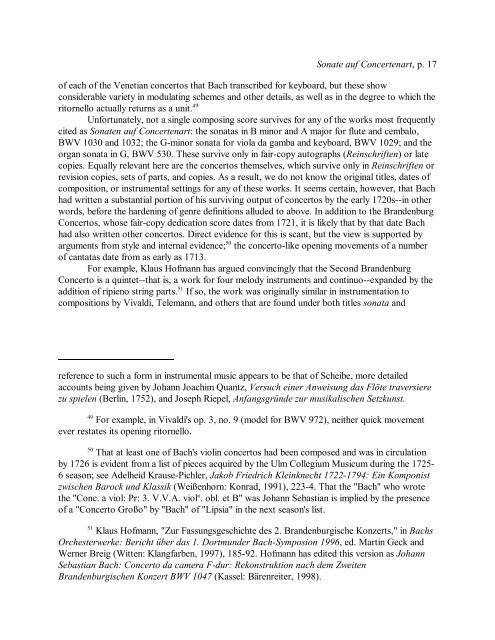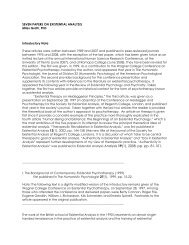The Sonate auf Concertenart: A Postmodern Invention? David ...
The Sonate auf Concertenart: A Postmodern Invention? David ...
The Sonate auf Concertenart: A Postmodern Invention? David ...
You also want an ePaper? Increase the reach of your titles
YUMPU automatically turns print PDFs into web optimized ePapers that Google loves.
<strong>Sonate</strong> <strong>auf</strong> <strong>Concertenart</strong>, p. 17<br />
of each of the Venetian concertos that Bach transcribed for keyboard, but these show<br />
considerable variety in modulating schemes and other details, as well as in the degree to which the<br />
ritornello actually returns as a unit. 49<br />
Unfortunately, not a single composing score survives for any of the works most frequently<br />
cited as <strong>Sonate</strong>n <strong>auf</strong> <strong>Concertenart</strong>: the sonatas in B minor and A major for flute and cembalo,<br />
BWV 1030 and 1032; the G-minor sonata for viola da gamba and keyboard, BWV 1029; and the<br />
organ sonata in G, BWV 530. <strong>The</strong>se survive only in fair-copy autographs (Reinschriften) or late<br />
copies. Equally relevant here are the concertos themselves, which survive only in Reinschriften or<br />
revision copies, sets of parts, and copies. As a result, we do not know the original titles, dates of<br />
composition, or instrumental settings for any of these works. It seems certain, however, that Bach<br />
had written a substantial portion of his surviving output of concertos by the early 1720s--in other<br />
words, before the hardening of genre definitions alluded to above. In addition to the Brandenburg<br />
Concertos, whose fair-copy dedication score dates from 1721, it is likely that by that date Bach<br />
had also written other concertos. Direct evidence for this is scant, but the view is supported by<br />
50<br />
arguments from style and internal evidence; the concerto-like opening movements of a number<br />
of cantatas date from as early as 1713.<br />
For example, Klaus Hofmann has argued convincingly that the Second Brandenburg<br />
Concerto is a quintet--that is, a work for four melody instruments and continuo--expanded by the<br />
51<br />
addition of ripieno string parts. If so, the work was originally similar in instrumentation to<br />
compositions by Vivaldi, Telemann, and others that are found under both titles sonata and<br />
reference to such a form in instrumental music appears to be that of Scheibe, more detailed<br />
accounts being given by Johann Joachim Quantz, Versuch einer Anweisung das Flöte traversiere<br />
zu spielen (Berlin, 1752), and Joseph Riepel, Anfangsgründe zur musikalischen Setzkunst.<br />
49<br />
For example, in Vivaldi's op. 3, no. 9 (model for BWV 972), neither quick movement<br />
ever restates its opening ritornello.<br />
50<br />
That at least one of Bach's violin concertos had been composed and was in circulation<br />
by 1726 is evident from a list of pieces acquired by the Ulm Collegium Musicum during the 1725-<br />
6 season; see Adelheid Krause-Pichler, Jakob Friedrich Kleinknecht 1722-1794: Ein Komponist<br />
zwischen Barock und Klassik (Weißenhorn: Konrad, 1991), 223-4. That the "Bach" who wrote<br />
o<br />
the "Conc. a viol: Pr: 3. V.V.A. viol . obl. et B" was Johann Sebastian is implied by the presence<br />
of a "Concerto Großo" by "Bach" of "Lipsia" in the next season's list.<br />
51<br />
Klaus Hofmann, "Zur Fassungsgeschichte des 2. Brandenburgische Konzerts," in Bachs<br />
Orchesterwerke: Bericht über das 1. Dortmunder Bach-Symposion 1996, ed. Martin Geck and<br />
Werner Breig (Witten: Klangfarben, 1997), 185-92. Hofmann has edited this version as Johann<br />
Sebastian Bach: Concerto da camera F-dur: Rekonstruktion nach dem Zweiten<br />
Brandenburgischen Konzert BWV 1047 (Kassel: Bärenreiter, 1998).















